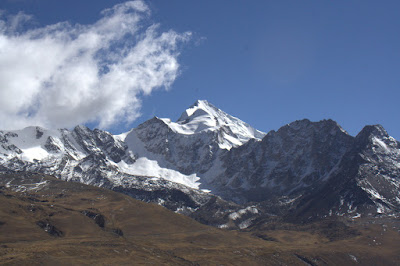
taken during our approach
We arrived at foot of the mountain around 1030am or so, and hoofed up all our equipment--cheesy yellow plastic boots, harness, ice axe, crampons, ropes, and the other usual stuff for camping and bitter cold. Other groups used sherpas to haul their gear up to the start of the glacier, but for some reason we didn´t--though later (after I took off my 60lb pack) it made me happy to feel like I wasn´t taking shortcuts through this thing. Anyway, the hike took about 2-3 hours up through a boulderfield until we ended up a refugee potosi--a wooden shack at 5200m (17060ft) that is frequented by climbers waiting to acclimatize a bit while the time ticks away until 1am when the summit attempt begins.
The rest of the day essentially consisted of this anxious waiting around, seeing how the altitude affected us, and watching other climbers have to turn around (text-book examples of Cheney-Stokes respirations). I took several photos during this time, which would turn out to be the majority of what I captured as the upcoming cold at 20000ft around 4am would prove too much for my desires to remove my overmits to navigate the camera.

a shot up the mountain from where we stayed, this was of course a false peak--about 1/6 of the way up from there
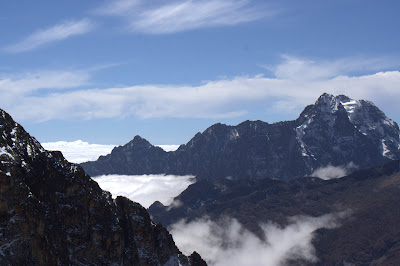
looking east towards amazonia and its cloudbank, past a few shorter mountains in the Cordillera Real

trying to relax and sleep inside the shack
The rest of the night I tried to eat aguacate and cheese sandwiches and drink mate de coca while my body rejected my attempts to sleep time and time again. I managed about an hour in total due to the altitude and a snowstorm that was happening outside--making me appreciate the refuge a little bit more. My guide Roberto (called el piano by the other guides, for why I never got a straight answer), told me it was 100 and time to suit up to go. Putting on all the gear, we stepped out into a frigid night, a fresh blanket off snow over everything, and a nearly full moon that light everything so brightly I would only turn on my lamp for knots and technical sections. Really a serene and beautiful night.
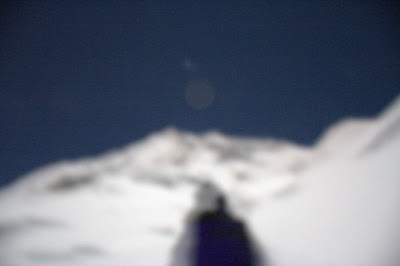
a blurry hand-held shot of Roberto advancing up the first section of glacier--shows how bright it was
So the work began, kicking on crampon in front of the next for several hours straight. It was hard work when we started, and only got more difficult as we progressed upward into thinner air. However, compared to other groups we made great time--Roberto and I quickly passed beyond all the other climbers and the entire morning was spent cutting a fresh path through the snow with nobody in sight. It was one of the more spiritual experiences I´ve ever had, just concentrating on putting one foot in front of the other in a steady rhythm while seeing all sorts of amazing glacial formations lit by this ethereal moonlight.
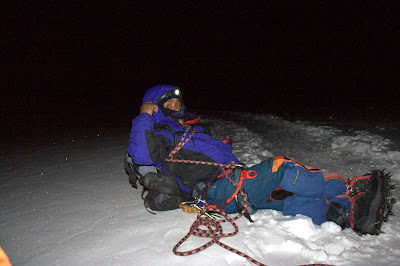
el piano

self-portrait
Normally, there is only one truly technical section of the climb aside from glacier travel--about 30 meters to step up to another glacier at about 50 degrees. Roberto thought I was doing fine, so he walked us over to an ice face, "mejorar escalar." We took a picture in front of it in the day on the way back down. Anyway, it was a blast--if a bit difficult at altitude.
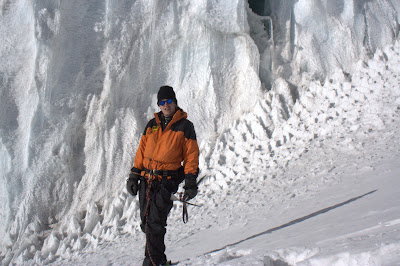
in front of the first technical section
Apparently this was a test/warmup, because later Roberto told me we would be leaving the normal route. The normal ascent crosses in front of the final summit face to a ridge that one is able to follow to the peak at a steady 20 degrees. Instead, we would go straight up the face itself--climbing what he told me was 60+ degrees for the final 210+ meters (it was a bit more than 3 sections of 70m rope when we repelled back down) to reach the 6088 meter summit. So we set off, and this was durissimo--all I could do was concentrate on getting good throws of my axe, setting my toes into firm ice that wouldn´t fall out, and pressure breathing to keep my lungs as open as possible. Compounding this the most bitter wind I´ve ever felt whiping across the face of our climb--causing me to lose feeling in my toes about halfway up (damn rental plastics)... Pretty scary, but by that point there was no question about continuing to the end.
After too long of this (I really have no idea exactly how long as my mind was a little hazy at this point though Roberto told me it usually takes 40 minutes to an hour) we pulled ourselves onto the summit--later we would find out we were the first ones of the day up there. The view was amazing, as everything was lit by the moon--lake titicaca, the lights of la paz, other peaks in the cordillera real, forming clouds over the amazon basin--incredible. Unfortunately all my shots are blurry--I had lost feeling in my right foot and my right hand was coming in and out, making a stable platform a bit difficult. I went to drink from my MSR bladder, but the water had frozen! It was too cold to stay there much longer than 10 minutes, so we decided to go back down and take a longer break once the sun had presented itself.
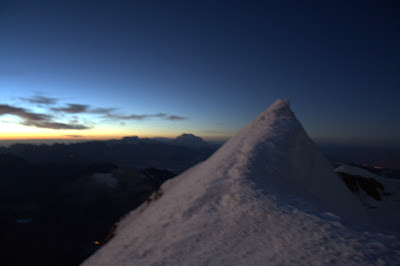
the peak of Huayna Potosi with a hint of sun starting to crawl out
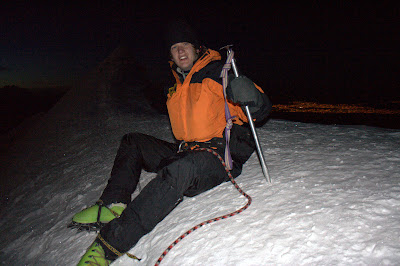
on the peak, you can see the lights of La Paz in the background
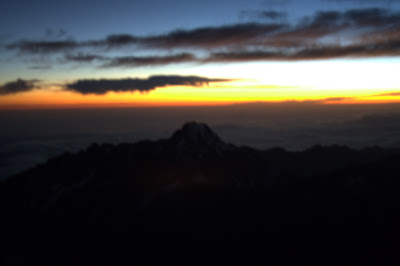
watching sunrise over amazonia
We rapelled back down the same face, and took a break at the bottom.
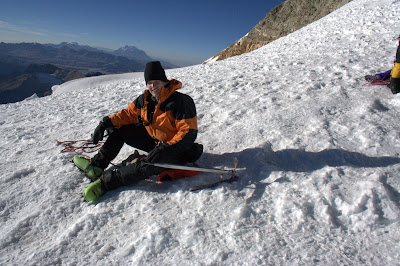
trying to rest and stay warm and breath
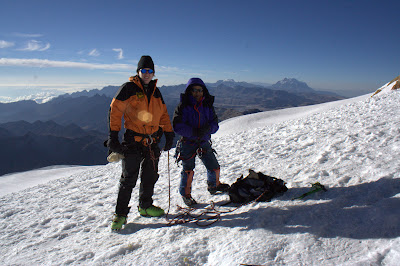
we ran into another group of climbers, and they took this picture of us
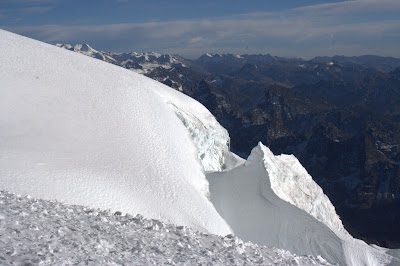
glacier formation
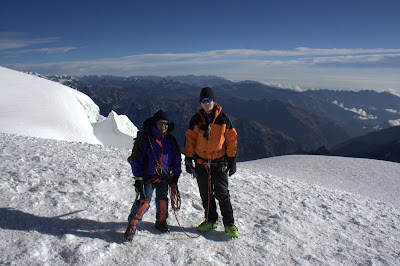
another
All that remained was the long walk back out, a few beers between the two of us, and a well-deserved shower.

1 comment:
Hi Erik,
Just wanted to let you know that I'm amazed, astounded, speechless (not really!), envious, terrified - at all of your climbing. Take care and we'll see you soon!
Emily's mom
Post a Comment